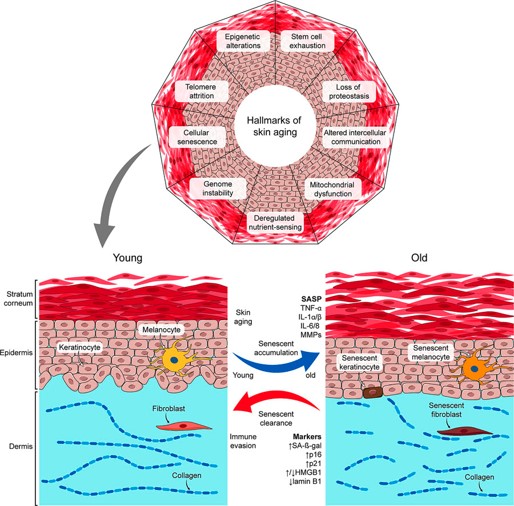
Cellular Senescence: Novel Interventions for Combating Skin Aging

Hallmarks of skin aging. An illustration of skin senescent cell accumulation and corresponding senescence-associated secretory phenotype (SASP) factor release in young versus old human skin models.
Researchers from the Mayo Clinic, led by Dr. Saranya Wyles, have shed new light on the complex processes of skin aging, emphasizing the critical role of cellular senescence. As the body’s largest organ, the skin is constantly subjected to intrinsic and extrinsic factors that influence its functionality and appearance over time. This comprehensive review published in Gerontology Journal highlights the significant dysregulation of skin cells and the deterioration of extracellular matrix fibers, leading to common age-related issues such as wrinkles, skin laxity, and pigmentary changes.
Understanding Cellular Senescence in Skin Aging
A key focus of the study is cellular senescence — a state of irreversible cell cycle arrest coupled with resistance to apoptosis and a pro-inflammatory secretory phenotype. This condition affects various skin cells, including melanocytes in the epidermis and fibroblasts in the dermis, contributing to the visible and structural changes associated with aging. By delving into the specific roles of these senescent cells, the researchers aim to enhance our understanding of skin aging and improve outcomes for aesthetic treatments.
Promising Senolytic Interventions
The Mayo Clinic team’s review also highlights innovative senolytic strategies designed to selectively eliminate senescent cells. These interventions hold promise for mitigating premature skin aging and improving overall skin health.
With a deeper understanding of the specific cellular changes and the potential of senolytic treatments, there is a promising future for enhancing skin health and appearance through both surgical and non-surgical methods.
Join Skin Ageing & Challenges on November 5-6, 2024 at Corinthia Palace Malta to know more about skin aging and potential senolytic interventions.
Did you like the news ? Please share it with your circle.